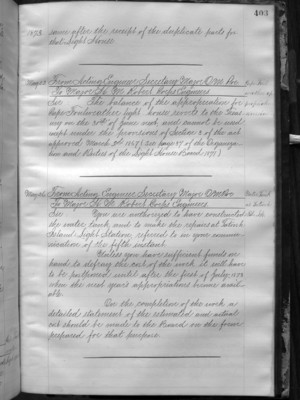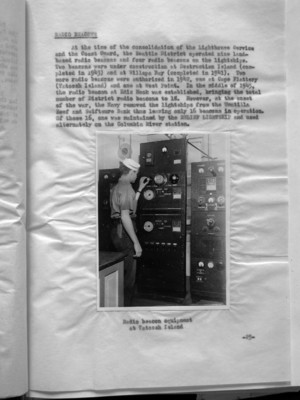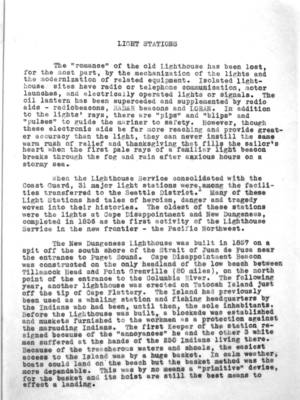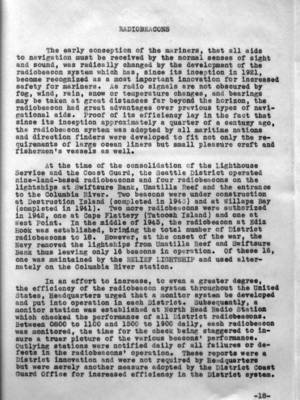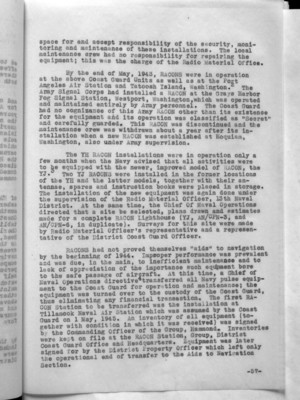Pages That Mention Tatoosh Island
1870-73 Lighthouse Board Annual Reports
50
1873.
same after the receipt of the duplicate parts for that Light House.
________________________________________
May 22. From Acting Engineer Secretary Major O. M. Poe. To Major H. M. Robert. Corps Engineers.
Sir: The balance of the appropriation for Cape Foulweather light-house reverts to the Treasury on the 30th of June next, and cannot be used except under the provisions of Section 3 of the act approved March 2nd 1867 (See page 37 of the Organization and Duties of the Light House Board 1871)
________________________________________
May 26.
From Acting Engineer Secretary Major O. M. Poe. To Major H. M. Robert. Corps Engineers.
Sir: You are authorized to have constructed the water tank and to make the repairs at Tatoosh Island Light Station, referred to in your communication of the fifth instant.
Unless you have sufficient funds on hand to defray the cost of the work it will have to be postponed until after the first of July, 1873 when the next year's appropriations become available.
On the completion of the work a detailed statement of the estimated and actual cost should be made to the Boards on the form prepared for that purpose.
________________________________________
Coast Guard District narrative histories 1945
8
At the time of the consolidation of the Lighthouse Service and the Coast Guard, the Seattle District operated nine land-based radio beacons and four radio beacons on the lightships. Two beacons were under construction at Destruction Island (completed in 1943) and at Willapa Bay (completed in 1941). Two more radio beacons were authorized in 1942, one at Cape Flattery (Tatoosh Island) and one at West Point. In the middle of 1945, the radio beacon at Ediz Hook was established, bringing the total number of District radio beacons to 18. However, at the onset of the war, the Navy removed the lightships from the Umatilla Reef and Swiftsure Bank thus leaving only 16 beacons in operation. Of these 16, one was maintained by the RELIEF LIGHTSHIP and used alternatively on the Columbia River station.
(Photo inserted here)
Radio beacon equipment at Tatoosh Island
-25-
20
LIGHT STATIONS
The "romance" of the old Lighthouse has been lost, for the most part, by the mechanization of the lights and the modernization of related equipment. Isolated lighthouse sites have radio or telephone communication, motor launches, and electrically operated lights or signals. The oil lantern has been superceded and supplemented by radio aids - raidobeacons, RADAR beacons and LORAN. In addition to the lights' rays, there are "pips" and "blips" and "pulses" to guide the mariner to safety. However, though these electronic aids be far more reaching and provide greater accuracy than the light, they can never instill the same warm rush of relief and thanksgiving that fills the sailor's heart when the first pale rays of a familiar light beacon breaks through the fog and rain after anxious hours on a stormy sea.
When the Lighthouse Service consolidated with the Coast Guard, 31 major light stations were among the facilities transferred to the Seattle District.¹ Many of these Light Stations had tales of heroism, danger and tragedy woven into their histories. The oldest of these stations were the lights at Cape Disappointment and New Dungeness, completed in 1856 as the first activity of the Lighthouse Service in the new frontier - the Pacific Northwest.
The New Dungeness Lighthouse was built in 1857 on a spit off the south shore of the Strait of Juan de Fuca near the entrance to Puget Sound. Cape Disappointment Beacon was constructed on the only headland of the low beach between Tillamook Head and Point Grenville (80 miles), on the north point of the entrance to the Columbia River. The following year, another lighthouse was erected on Tatoosh Island just off the tip of Cape Flattery. The Island had previously been used as a whaling station and fishing headquarters by the Indians who had been, until then, the sole inhabitants. Before the Lighthouse was built, a blockade was established and muskets furnished to the workmen as protection against marauding Indians. The first Keeper of the station resigned because of the "annoyances" he and the other 3 white men suffered at the hands of the 250 Indians living there. Because of the treacherous waters and shoals, the easiest access to the Island was by a huge basket. In calm weather, boats could land on the beach but the basket method was the more dependable. This was by no means a "primitive" devise, for the basket and its hoist are still the best means to effect a landing.
37
The early conception of the mariners, that all aids to navigation must be received by the normal senses of sight and sound, was radically changed by the development of the radiobeacon system which has, since its inception in 1921, become recognized as a most important innovation for increased safety for mariners. As radio signals are not obscured by fog, wind, rain, snow or temperature changes, and bearings may be taken at great distances far beyond the horizon, the radiobeacon had great advantages over previous types of navigational aids. Proof of its efficiency lay in the fact that since its inception approximately a quarter of a century ago, the radiobeacon system was adopted by all maritime nations and direction finders were developed to fit not only the requirements of large ocean liners, but small pleasure craft and fisherman's vessels as well.
At the time of the consolidation of the Lighthouse Service and the Coast Guard, the Seattle District operated nine-land-based radiobeacons and four radiobeacons on the lightships at Swiftsure Bank, Umatilla Reef and the entrance to the Columbia River. Two beacons were under construction at Destruction Island (completed in 1943) and at Willapa Bay (completed in 1941). Two more radiobeacons were authorized in 1842, one at Cape Flattery (Tatoosh Island) and one at West Point. In the middle of 1945, the radiobeacon at Ediz Hook was established, bringing the total number of District radiobeacons to 18. However, at the onset of the war, the Navy removed the lightships from Umatilla Reef and Swiftsure Bank thus leaving only 16 beacons in operation. Of these 16, one was maintained by the RELIEF LIGHTSHIP and used alternately on the Columbia River station.
In an effort to increase, to even a greater degree, the efficiency of the radiobeacon system throughout the United States, headquarters urged that a monitor system be developed and put into operation in each District. Subsequently, a monitor station was established at North head Radio Station which checked the performance of all District radiobeacons. Between 0800 to 1100 and 1500 to 1900 daily, each radiobeacon was monitored, the time for the check being staggered to insure a truer picture of the various beacons' performance. Outlying stations were notified daily of all failures or defects in the radiobeacons' operation. These reports were a District innovation and were not required by Headquarters but were merely another measure adopted by the District Coast Guard Office for increased efficiency in the District system.
-18-
77
space for and accept responsibility of the security, monitoring and maintenance of these installations. The local maintenance crew had no responsibility for repairing the equipment; this was the charge of the Radio Material Office.
By the end of May, 1943, RACONS were in operation at the above Coast Guard Units as well as at the Port Angeles Air Station and Tatoosh Island, Washington. The Army Signal Corps had installed a RACON at the Grays Harbor Fog Signal Station, Westport, Washington, which was operated and maintained entirely by Army personnel. The Coast Guard had no cognizance of this Army RACON other than its existence for the equipment and its operation was classified as "Secret" and carefully guarded. This RACON was discontinued and the maintenance crew was withdrawn about a year after its installation when a new RACON was established at Hoquiam, Washington, also under Army supervision.
The YH RACON installations were in operation only a few months when the Navy advised that all activities were to be equipped with the newer, improved model of RACON, the YJ.³ Two YJ RACONS were installed in the former locations of the YH and the latter models, together with their antennae, spares and instruction books were placed in storage. The installation of the new equipment was again done under the supervision of the Radio Material Officer, 13th Naval District. At the same time, the Chief Of Naval Operations directed that a site be selected, plans drawn and estimates made for a complete RACON Lighthouse (YJ, AN/CPN-3, and AN/CPN-6, in duplicate). Surveys for this site were made by Radio Material Officer's representative and a representative of the District Coast Guard Officer.
RACONS had not proved themselves "aids" to navigation by the beginning of 1944. Improper performance was prevalent and was due, in the main, to inefficient maintenance and to lack of appreciation of the importance such equipment bore to the safe passage of aircraft. At this time, a Chief of Naval Operations directive^4 transferred all Navy pulse equipment to the Coast Guard for operation and maintenance; the equipment was turned over to the custody of the Coast Guard, thus eliminating any financial transaction. The first RACON Station to be transferred was the installation at Tillamook Naval Air Station which was assumed by the Coast Guard on 1 May, 1945. An inventory of all equipment (together with condition in which it was received) was signed by the Commanding Officer of the Group, Hammond. Inventories were kept on file at the RACON Station, Group, District Coast Guard Office and Headquarters. Equipment was later signed for by the District Property Officer which left only the operational end of transfer to the Aids to Navigation Section.
-57-
